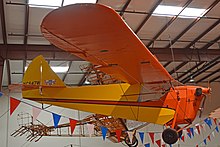

| E-107 | |
|---|---|

| |
| E107 on display | |
| Type | Flat-twin aircraft engine |
| National origin | United States of America |
| Manufacturer | Aeronautical Corporation of America |
| Designer | Ray Poole and Robert Galloway |
| First run | 1929 |
| Major applications | Aeronca C-2 |
| Number built | 115 |
| Variants | Aeronca E-113 |
The Aeronca E-107 was one of the first low-cost reliable engines of the post-World War I era.[1]

The E-107A was a production aviation flathead engine designed to replace a Morehouse engine on the first prototype of the Aeronca C-2. The first five were produced without cooling fins on the crankcase, but with all versions having air-cooling fins atop the cylinder heads, similar to many air-cooled two-stroke engines in appearance. A Winfleld Model 5 carburetor was standard for the engine.[2] The E-107 was replaced by the uprated, overhead valvetrain E-113 engine based on the same design.[3]
Data from [5]
Comparable engines
Related lists